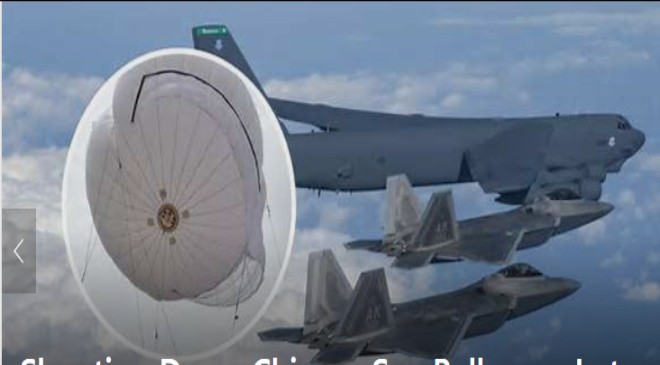Asuspected Chinese spy balloon may be harder to shoot down than it would appear because of their “survivable” nature, according to military research. However, analysts say hitting one is easy but the difficulty stems from controlling its crash landing.
Also Read- Netflix just showed us a glimpse of how it plans to crack down on password sharing
China has said it was looking into reports about the spy balloon and said that it had no wish to violate U.S. airspace, while Chinese experts have pointed the finger at America.
A senior U.S. defense official said the Pentagon had “very high confidence” that it was a Chinese balloon surveilling sensitive sites in the U.S., according to the Associated Press.
The high-altitude balloon—which the U.S. has been tracking over its airspace for a few days—was sighted on Wednesday over Billings, Montana, and is believed to have travelled over western Canada and Alaska. The Pentagon has decided not to shoot it down over safety concerns for people on the ground.
Also Read- Scientists Have a Genius Plan: Turn Abandoned Mines Into Gravity Batteries
‘Inherently Stealthy’
According to a 2009 research paper on stratospheric airships by Kevin Massie, a major in the U.S. Air Force, despite their large size they are “difficult to detect and if hit, do not immediately descend.”\
“Stratospheric airships are inherently stealthy. Because they contain inert gas and do not produce a significant amount of heat, [stratospheric airships] present a miniscule infrared signature at high altitude,” he wrote.
“Because of their non-metallic structure and covering and a lack of rough edges, [stratospheric airships] also present a minimal radar return. Even with their immense size, [they] are also difficult to see optically at high altitude,” Massie added.
However, the U.S.’s capability for detecting such objects may have improved in the past decade. And the balloon currently over the U.S. was spotted from a commercial airliner, according to the Wall Street Journal.
Also Read– What is a multi-gig router and do you need one?
Rebecca Grant Ph.D., a national security analyst and aerospace expert at IRIS Independent Research, told Newsweek that tracking the balloon was “no problem,” adding: “I expect they saw this on its way over across the Pacific, and it can be tracked internally by fighter radars, like the F-22s or F-15.”
She noted: “This thing is enormous.”
Chinese media, citing U.S. information, said it was 40 cubic meters in size.
‘Inherently Survivable’
The key issue is that high-altitude balloons, by design, are able to stay in the air for a long time, even if punctured. Massie wrote that airships are “inherently survivable,” usually containing inert helium which prevent them from turning into a “flaming wreckage.”
Equally, balloons of this kind have an internal pressure of less than one pound per square inch, Massie said. “Holes created by damage result in slow leaks and slow descents,” he added.
Massie noted an example from 1998, in which Canadian F-18s shot at a wayward 100 meter weather balloon, which after being hit by 1,000 rounds managed to stay airborne for another six days.
Also Read– Earth’s inner core may have stopped turning and could go into reverse, study suggests

“It’s no problem really to shoot at [the balloon],” Grant explained. “Consider that a fighter could use an air-to-air missile if it needed to be precise—and if the balloon is low enough, it’s possible to use a gun as well.
“But the problem is when you puncture it, how long does it take for the gas to flow out, and as the balloon deflates, how long does it take, where does it go—so the issue is precisely predicting and controlling the potential crash sites,” she added.
Also Read– Scientists Have a Genius Plan: Turn Abandoned Mines Into Gravity Batteries
A senior administration official said that President Joe Biden had been briefed on the matter and had asked for military options, but had accepted the advice of defense chiefs against shooting the balloon down over fears it could end up hurting people on the ground.
“It sounds like they’ve considered shooting it down and probably those options are still on the table,” Grant said. “What’s holding them back on the technical side is the issue controlling the crash site.”
Could the Balloon Be Captured?
Asked if the U.S. military could somehow capture the balloon to avoid an uncontrolled crash, Grant commented: “Back in Vietnam days, they did use helicopters and cargo planes to sort of fling reconnaissance drones and return them so they could get the film, so it’s not so far-fetched; it’s just been a while since we did anything like that. I’m sure the U.S. military could create a controlled crash of this balloon if the president asked them to.”
Also Read– What is a multi-gig router and do you need one?
Meanwhile, Chinese talking heads have suggested the U.S. shoot the balloon down, insinuating that it did not originate from China.
Expert Zhang Xuefeng told the Global Times, a Chinese state mouthpiece, that it may be that the balloon had been confected by the U.S.
“I suggest the U.S. shoot down the balloon and accuse others after it has found some evidence,” he commented.
Also Read– Earth’s inner core may have stopped turning and could go into reverse, study suggests
Huang Zhicheng, an expert on aerodynamics, told the English-language outlet that a balloon of its reported size could fly from China to America, and that only the two nations had the technical capacity to create one.



































